Discovering what people want or need and then creating it and presenting it to them is at the core of every business. However, you need to present your product in a way that feels natural and unforced, and what better way to do that than with content marketing?
Content marketing has become an indelible part of any marketing strategy because it helps to build brand awareness, attract leads, engage readers, increase conversion, and generate more business. In other words, it pays off big time.
But the world of content marketing is dynamic, and trends move fast, so for this article, we've curated various content marketing statistics to help you execute a flawless marketing strategy. Let's go!
Table of Contents
- Content Marketing Overview
- 2022 Content Marketing Statistics
- Our Top Picks: Key Content Marketing Statistics
- Content Marketing Strategy Statistics
- B2C Content Marketing Statistics
- B2B Content Marketing Statistics
- Blogging Marketing Statistics
- Social Media Marketing Statistics
- Email Marketing Statistics
- Video Marketing Statistics
- Podcasting Statistics
- Organic Search Statistics
- FAQs
- Over and Out
Content Marketing Overview
Content marketing is producing and distributing relevant and useful online material (such as blogs, social media posts, and videos) to generate interest in a brand's goods or services without directly promoting it.
The goal is to produce materials that resonate with what the consumers are interested in and provide value. This way, companies can build a lasting relationship with their customers, which will lead to increased traffic and engagement and, of course, more revenue.
Types of Content Marketing
There are many types of content marketing you can add to your arsenal. You just need to decide which ones will be most worth the investment and can help you achieve your goals.
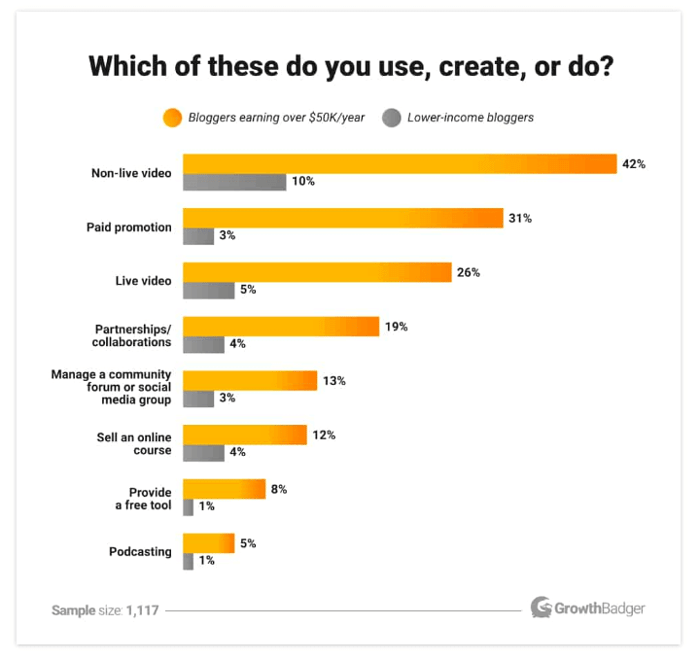
Of course, you'll get the best results by employing several different tactics, but remember to choose the ones that represent your strengths the best.
Blogs
For most businesses, adding a blog to their websites is almost a given. Blogs offer you the best space to showcase your brand identity and build relationships with your customers while also providing interesting content.

The most important part of having a blog, though, is that it helps with SEO, which helps drive organic traffic to your site. We've previously written about the best Shopify blog examples, so you can check that out to see how brands express themselves through blogging. We also included a comprehensive guide on developing a content strategy, which you'll surely find useful as well.
Videos
Videos are the type of content that's immediately engaging, so you really can't go wrong with them.
Some companies opt to diversify their online presence and start a YouTube channel where they post educational and informational videos. Sometimes, they even embed them in their blog posts. But you can also make short videos to post on social media like Instagram or TikTok. It's really versatile.
No matter your niche, there's plenty of variety with video content, so if you get creative, you can produce some really great and attention-grabbing content that'll set you apart from the rest.
Email marketing is one of the most commonly used content marketing tactics because it's personalized and it's quite cost-effective. Plus, it's excellent for increasing leads when done right.
This entails sending engaging emails that will be of actual value to your potential customers. No one wants to waste time reading through yet another advertisement unless it provides something useful. For example, the more interesting and unique your newsletters are, the better the chances of long-term engagement, and you won't have to worry about losing subscriptions.
A good example is something like a birthday special email, where the subscriber receives a tailored deal on their birthday. Like this one from Sephora:

However, email marketing needs to be done in moderation as no one enjoys being advertised to multiple times a day.
Social Media Posts
Social media has become a powerful driving force in the world of marketing and, for some businesses, even the main platform for communication with their audience. And it's no wonder – most people use some form of social media, making it easier to reach them.

Of course, this entails the social media your target audience uses regularly and focusing most of your efforts on producing quality content there. However, it's recommended to be active on as many platforms as possible to reach many consumers. Exposure is always beneficial, and what better way than through social media?
Infographics
Infographics are a great way to share interesting and informational content. They're fun and visually pleasing, and you can pack large chunks of data presented in a concise way.
Infographics are rather versatile, as you can include them in many other promotional content types. For example, infographics are perfect for social media, which is the ideal place for sharing tidbits of information.

But other than that, you can create infographics to include in e-books and even in promotional emails, depending on the content. If we were to stretch it, you could also include them in animated educational videos. The possibilities are endless!
Podcasts
Podcasts are truly a reflection of today's trends, and we're not complaining. While they're not as easily digestible as other forms of content because of the nature of their format, podcasts can give a voice to your brand, literally.
Podcasts come in different forms. You can start a traditional audio podcast on Spotify, Apple Podcasts, or Google Podcasts like BigCommerce and Shopify have, but you can also do something different and make a video podcast on YouTube – some brands do both. Then, subscribers can choose their preferred platform, and really, it's an ingenious way to disperse your presence while recycling content.
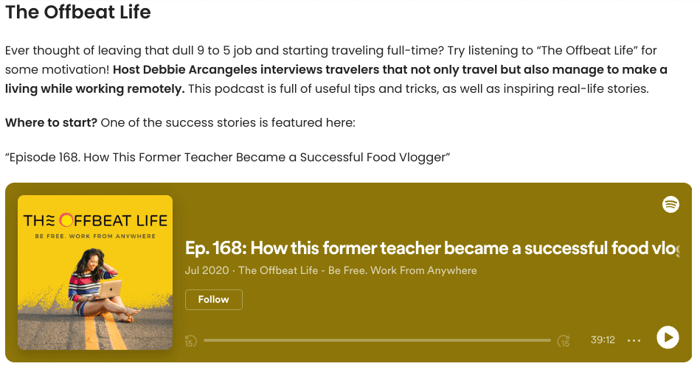
In a way, they provide some sort of reassurance about your relationship with your customers because you'll know that the listeners didn't just stumble upon it by accident.
E-books
E-books are a very good way of offering valuable information. You can think of them as a huge blog post that provides content your potential customers will find useful. It's like giving out a handout, only long-form and much more helpful.

Courses
If your product is SaaS, then offering online courses can be a great way for you to attract leads. It's the perfect way to let them test your product before they decide to buy it.

Learning is an invaluable skill, and most leads will be immediately interested in your product if they know that they have a repository of information and some guidance, especially beginners. Plus, courses are interactive and fun, but they also offer an experience, which is beyond important.
Webinars
Similar to online courses, webinars are also very educational. They may not be mainstream content because each webinar deals with a very specific topic, but as with podcasts, you'll know that the attendees really want to be there and are interested in what the speaker has to say.
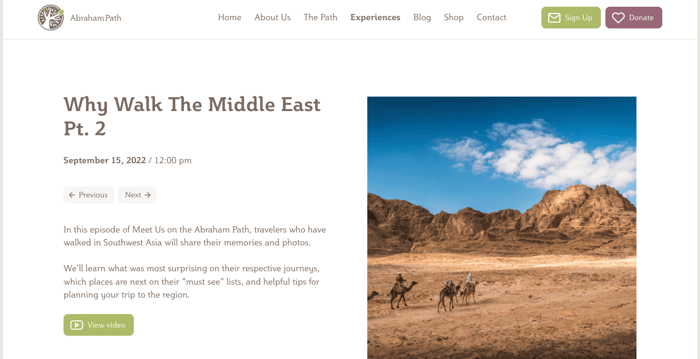
You can later save the videos of the webcast to be available for people who couldn't attend and maybe even attract a new audience along the way.
2022 Content Marketing Statistics
We prepared some of the most interesting and relevant content marketing statistics to inform your marketing strategy and help you get a better grasp of what's currently going on in the sphere of content marketing.
Our Top Picks: Key Content Marketing Statistics
Here are our picks of the most relevant statistics you need to see before we get into the specifics.
For 81% of marketers, producing content is an essential business strategy. (Content Marketing Institute)
32% of marketers have spent between 10-29% of their total marketing budget on content marketing, while only 3% have spent over 70% of their marketing budget. (Semrush)
To improve their content marketing strategy, most companies want to focus on investing in social media and community building, producing better-written content, and improving their content promotion and distribution. (Semrush)
51% of the businesses that actively invest in content marketing publish content every single day. (The Manifest)
Internet users are twice as likely to share video content with their friends than any other type of content, like articles, blog posts, or social media posts. (Wyzowl)
The average time a reader spends on a newsletter is approximately 51 seconds. (Nielsen)
Content Marketing Strategy Statistics
Companies that are serious about their business know very well that having a good content marketing strategy can take you places. It gives your brand identity and ensures your product finds the right people at the right time.
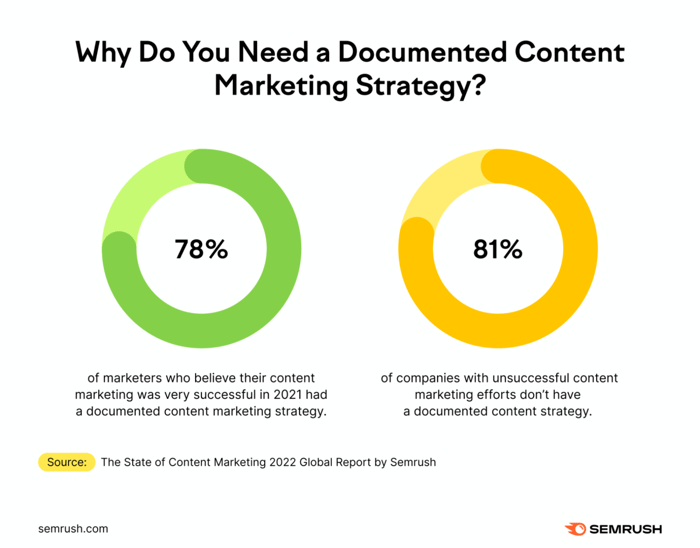
Here are some content marketing strategy stats, also by Semrush:
The search entry “What is content marketing” has increased by 22% in 2022, whereas average monthly searches for “content marketing strategy” fell by 33%.
The top Google search queries related to content marketing are “content marketing example,” “content marketing strategy,” and “content marketing institute.”
55% of marketers have said that the best way to increase conversion rates and promote growth is through really understanding your target customers' personas.
Content marketing is part of the marketing strategy of an astounding 97% of marketers.
The three content marketing strategy tactics that are the most successful are: improving the content's quality (55%), SEO (46%), and creating more video and visual content (41%).
The three tactics that have helped marketers to rank in organic search results are: making better and more authentic content (61%), creating more content and posting more often (45%), and doing better keyword research (43%).
The biggest challenges for content marketers are attracting quality leads with the content they produce (41%) and generating enough traffic, as well as promoting their content (39%).
Measuring organic traffic (51%) is the main metric marketers use to determine the success of their marketing efforts. It's followed by search ranking (42%) and leads (40%).
B2C Content Marketing Statistics
B2C content marketing allows you to reach a wide audience, increase brand awareness, and of course, increase sales. B2C content marketing is imperative for businesses that are looking to stay stable in the constantly-changing currents of the world of commerce.
Here are the most notable B2C stats for 2022, courtesy of the Content Marketing Institute:
Most B2C marketers either have an established content marketing strategy or plan on developing one within the coming year; only 6% don't have a strategy nor plan on employing one.
The top three goals B2C businesses report achieving in the last year by employing content marketing are creating brand awareness (81%), building credibility and trust (76%), and educating audiences (71%).
The most common outsourced activity for B2C businesses is content creation (75%), followed by content distribution (40%).
Blog posts/short articles (83%), email newsletters (74%), videos (62%), and infographics/charts/photos (62%) are the most commonly produced types of content for B2B marketers.
48% of B2C marketers have said that their organization has established an online community.
The top three content distribution channels for B2C marketers are social media platforms (82%), the organization's own website/blog (79%), and email (76%).
Facebook (97%) and Instagram (81%) are the two most commonly used platforms in B2C marketing, followed by YouTube (72%), Twitter (67%), and LinkedIn (65%).
The three most commonly used technologies by B2C businesses for an improved workflow are analytics tools (85%), social media publishing/analytics (73%), and email marketing software (71%).
B2B Content Marketing Statistics
Similar to B2C marketing, B2B also focuses on acquiring leads, generating more traffic, and increasing sales. Different companies have different approaches toward B2B marketing, depending on their target customers and what they're trying to achieve.

Let's see some stats.
Most B2B marketers either have an already documented content marketing strategy or plan to develop one within a year, while only 4% don't have any plans of employing a strategy. (Content Marketing Institute)
In response to the pandemic, most B2B marketers made adjustments to their content marketing strategy. The top three include changes in the messaging/targeting strategy (70%), adjusting the editorial calendar (64%), and changing content distribution/promotion strategy (53%). (Content Marketing Institute)
An impressive 83% of B2B marketers attribute their success over the last 12 months to the value that their content provides. (Content Marketing Institute)
87% of B2B marketers place a higher priority on the informational requirements of the audience than on the company's sales or promotional messages. (Content Marketing Institute)
The majority of B2B marketers who use content marketing outsource at least one content marketing activity. (Content Marketing Institute)
32% of B2B companies allocate just 5% of their budget to marketing, while only 13% allocate 15% or more. (Statista)
46% of B2B companies decided to increase the budget for content marketing. (Statista)
The average size of a B2B content team has increased by 31% compared to the past year. (Content Marketing Institute)
96% of B2B content marketers use LinkedIn. (Content Marketing Institute)
For 78% of B2B marketers, doing keyword research is the main part of their SEO strategy. (Content Marketing Institute)
Blogging Marketing Statistics
In recent years, blogging has become nearly synonymous with having a content marketing strategy – period, and for a good reason. Blogging is imperative for driving traffic to your site, increasing conversion, building rapport with your audience, and giving a voice to your brand.

Of course, it can even help you make more money – check out our rundown of the highest-paid bloggers.
By posting relevant content that's also optimized for search engines, your chances of carving out a way for your business in the web jungle become bigger with every step. And to do this, you need a faithful sidekick to help you achieve your goals.
Meet DropInBlog, the friendliest and most agile blogging tool you'll ever use. DropInBlog has advanced SEO features to help you with ranking high on SERPs, and it just makes your blogging experience a whole lot better. The best part is that it fits right into the design of your theme. Check it out if you want – there's a free trial.
Now, since blogging is truly essential, let's see some blogging stats.
As of 2021, there are over 600 million blogs residing on the internet and 1.9 billion websites. (Backlinko)
Over 3 million blog posts are published each year. (Growth Badger)
77% of online users read blogs, but 70% of people who read blogs only skim through the content rather than read it word for word because they're interested in learning the information relevant to their immediate needs. (Social Media Today, Nielsen)
Internet users prefer to read content that takes less than seven minutes to read, anything longer than that, and the engagement with the post starts to drop. (Medium).
73% of blog readers tend to skim through articles, while 27% like to read thoroughly. (HubSpot)
75% of blog readers prefer blog posts that are no more than 1,000 words, while only 5% prefer longer articles, over 2,000 words. (Contently)
The most popular types of blog posts are how-to articles (77%), and right behind it, news and trends (49%) and guides and e-books (47%). (Statista)
An impressive 76% of marketers use blogs as one of their primary ways to distribute information. (Content Marketing Institute)
By the end of 2026, the global content marketing industry is expected to grow by $487.24 billion. (ReportLinker)
30% of bloggers don't earn any money, but those that do, earn money primarily through affiliate marketing, sponsored posts, ads, their own products, and online courses. (TechJury, RankIQ) We've previously written about how much beauty bloggers make, so you can check it out.
The most lucrative blogging niche is blogging about food, as research shows that food bloggers have the highest income on average compared to other niches. (RankIQ)
In line with this, see our article on the highest-paid food bloggers for some more interesting information.The most common niches for starting a blog are lifestyle (25%), travel (18%), and food (13%). (RankIQ)
Four blogging niches that get the highest traffic (food, lifestyle, travel, arts & crafts) make up 74% of all high-traffic blogs. (RankIQ)
It takes around four hours to write a typical blog post. (Orbit Media)
Bloggers who collaborate with influencers in any way tend to get better results. (Orbit Media)
A staggering 97% of all bloggers primarily use social media to get their content out in the world, while 66% use email marketing. (Statista)
Generally, it costs $77.80 on average to publish a paid guest post. (Ahrefs)
Social Media Marketing Statistics
If there's anything that has transformed the content marketing game forever, it's social media, hands down.
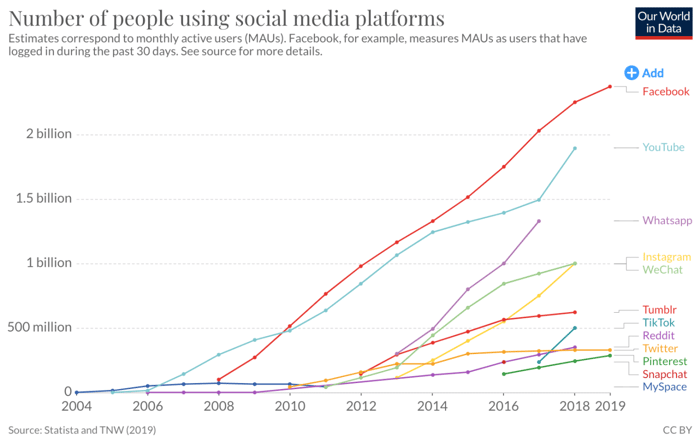
When the first social media networks emerged, no one could've predicted how important they'll become later on. Indeed, today, having a social media strategy is an indelible part of any business's marketing strategy. Having said that, social media trends move faster than lightning, so it takes a lot of grit to keep up with it.
Let's see some social media marketing stats for 2022 to know where we stand.
Over 50% of marketers are turning towards Facebook, Instagram, and TikTok for marketing. (HubSpot)
Of all social media platforms that are currently popular, Facebook still remains at the top by being used by 62% of social media marketers. Facebook is followed by YouTube (54%), TikTok (52%), Instagram (49%), and finally, Twitter (45%) and LinkedIn (35%). (HubSpot)
25% of marketers think that Facebook has the highest ROI of all social media platforms, and 29% find that it has the highest engagement rates compared to the others. (HubSpot)
Short-form videos continue to grow in popularity and have turned out to be extremely useful for marketing as well. (HubSpot)
Millennials are targeted by an impressive 84% of social media marketers. (HubSpot)
According to 80% of marketers, funny content generates the most visits on social media. (HubSpot)
67% of marketers like to work with smaller to medium-sized influencers with follower/subscriber counts between 10k-100k. (HubSpot)
Instagram is utilized by 67% of brands for influencer marketing. (ThriveMyWay)
According to 80% of marketers, funny content generates the most visits on social media. (HubSpot)
In general, the best time for posting on social media are Tuesdays through Thursdays between 9 a.m. and 10 a.m., while the worst time is Sundays. (SproutSocial)
Roughly 52% of all Instagram users are aged 18-34. (Statista)
A staggering 98% of marketers claim that Instagram is unmatched for influencer marketing. (Sprout Social)
The types of content that have the biggest ROI on social media include funny content, interactive content, content that represents the brand's voice, relatable content, and educational content. (HubSpot)
Social media users interact 21.2% more with videos than they do with images or carousels. (SproutSocial)
LinkedIn accounts for more than 46% of all social media traffic to business websites. (LinkedIn)
Email Marketing Statistics
Some may say it's outdated, but email marketing has so many benefits that it's hard to see the downsides, which is why it's still one of the top marketing practices.
Email marketing not only saves you a ton of costs on advertising, but it gives you space to create personalized content to be read by your target audience at their own convenience. It can boost conversion rates, has a generally high ROI, and much more.
Needless to say, email marketing shouldn't be overused, as you don't want to bombard your subscribers with too many promotional emails to the point where they just start to ignore them.
Here's what the stats have to say about email marketing in 2022:
Globally, the number of emails sent and received each day has been steadily increasing, and by the end of 2023, it's predicted to reach 347.3 billion. (Statista)
The total revenue from email marketing around the world is expected to continue growing steadily in the coming years and reach $17.9 billion by the end of 2027. (Statista)
Email marketing is currently among the top three marketing channels, right behind blog and social media, respectively, with 35% of businesses using it to promote their brand and generate new leads. (HubSpot)
For a whopping 95% of marketers, email marketing is a highly effective strategy for achieving their business goals. (HubSpot)
For every $1 spent on email marketing, marketers earn an average of $36 in return. (Litmus)
The industries with the highest ROI from email marketing are retail, e-commerce, and consumer goods, with a ratio of 45:1. Marketing, PR, and advertising agencies come close at 42:1, followed by software and technology with 36:1, and finally, media, publishing, events, sports, and entertainment with a ratio of 32:1. (Litmus)
Responsive email templates tend to get 15% more clicks on all types of devices, which in turn increases engagement. (Mailchimp)
36% of all email marketing revenue comes from segmented emails. (Barilliance)
33% of marketers send emails once a week, while 26% send emails a few times per month. (Databox)
A/B and spam testing your email campaigns, as well as performing quality assurance, increases your ROI by up to 28%. (Litmus)
Video Marketing Statistics
Video marketing has always been important, but what's changed over time is that now it has become an integral part of a marketing strategy.
Video production is much more accessible these days, so it's no wonder that most brands have started to include videos on nearly every platform. It helps to educate and increase engagement and, most importantly, market their services or products. After all, there's nothing like a punchy video to grab your attention.
Here's how video marketing fares in 2022:
The vast majority of businesses, 86% to be precise, are still using video as one of their main marketing tools. (Wyzowl)
A striking 92% of marketers have said that video is a big part of their marketing strategy. (Wyzowl)
As far as video platforms go, 88% of marketers said that they intend to use YouTube in their marketing strategies, while 68% opted for Instagram video and 65% for Facebook video. (Wyzowl)
YouTube, the largest video streaming platform, stands at the top among 100 of the most visited websites in the world, with over 8.2 billion monthly search traffic. (Ahrefs)
At 37%, video was the highest-performing content type in 2021, with the trend continuing into 2022. (Semrush)
There is a 10% increase in non-video marketers who proclaimed that they'll start using video in their marketing strategies in 2022. (Wyzowl)
For 43% of marketers, video became a necessary part of their strategy following the COVID-19 pandemic. (Wyzowl)
As far as forms of videography go, live-action video is used by 42% of businesses, animated video is used by 33%, and screen recording video by 15%. (Wyzowl)
Of all types of video, explainer videos and social media videos are the most commonly used by 74% and 68% of businesses, respectively, followed by presentation videos (50%), video testimonials (46%), and video ads (42%) as the top five. (Wyzowl)
According to 39% of marketers, short-form videos under 60 seconds (TikTok, Instagram Reels, YouTube Shorts) have the highest ROI. (HubSpot)
87% of marketers claim that using video marketing has increased their traffic, while it helped 86% to acquire new customers. (Wyzowl)
A staggering 94% of marketers agree that the best length for a marketing video is under 10 minutes, or more specifically, between 1-3 minutes. (HubSpot)
70% of YouTube viewers have reported that they have bought a service or a product after seeing it on the platform. (Google)
An overwhelming 96% of consumers have said that watching explainer videos helps them to learn more about a product or service. (Wyzowl)
Podcasting Statistics
In the true fashion of our era, podcasts have become an increasingly prominent form of content marketing in the last 10 years. So much so, in fact, that even platforms like BigCommerce and Shopify employ it in their marketing tactics.
Podcasts are engaging, entertaining, and educational, so it's no wonder that many people choose to listen to a podcast when they go for a run, while commuting, or even while doing chores around the house.
But, let's see how really relevant podcasting is in 2022.
There are over 4 million podcasts being currently produced on a global scale. (Podcast Index)
An estimated 79% of the US population over 12 years old is familiar with podcasts, while 41% are monthly listeners of podcasts. (Edison Research)
80% of people who listen to podcasts regularly listen to all episodes or most of each episode. (Podcast Insights)
By the end of 2025 the number of monthly podcast listeners is expected to rise to over 144 million listeners in the US only. (Insider Intelligence)
64% of people listen to podcasts at home, while smartphones are the most commonly used devices for listening to podcasts by 73% of listeners, as opposed to 13%, who listen on their computer. (Edison Research)
The largest age demographic of monthly podcast listeners in the US is between ages 14-34 (47%), followed by ages 35-54 (33%), and age 55+ (20%). (Edison Research)
Spotify is the most popular platform for streaming podcasts, used by 25% of all US listeners, and it's followed by Apple Podcasts and Google podcasts with 20% and 16% of the listeners, respectively. (Statista)
Comedy is the most popular podcast genre, followed by News and Society & Culture. (Edison Research)
Organic Search Statistics
Investing in organic search by employing the best SEO practices for your website can have the biggest impact on generating continuous organic traffic in the long run.
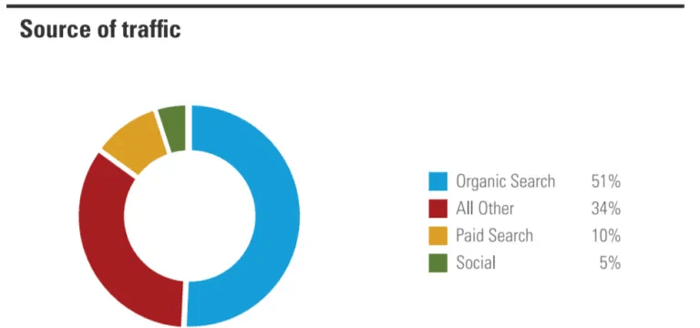
Most companies nowadays know the value of organic search, which is why they do diligent keyword research and optimize their websites for search engines by adding backlinks, posting relevant content, and using internal linking, to name a few.
Here are some interesting stats related to organic search:
69% of marketers actively invest in SEO. (HubSpot)
The top result in Google receives 27.6% of all clicks, meaning that the link that's listed first has the highest organic clickthrough rate (CTR). (Backlinko)
Most people stay within the first search page. In Google searches, only 0.63% of users clicked on results on the second page. (Backlinko)
Moving up one position on Google increases the clickthrough rate by 32.3%. (Backlinko)
The longer the keyword, the bigger the clickthrough rate, with the best results being when the keyword contains 4 words, but 5-9 word keywords can also be successful. (Backlinko)
Backlinks are more important than ever, as the more backlinks a page has, the more organic traffic it gets. (Ahrefs).
A staggering 90.63% of websites don't get any organic traffic from Google, and only 5.29% of them get 10 monthly visits at most. (Ahrefs)
The top three key performance indicators for SEO are time spent on page, organic traffic, and keyword ranking. (HubSpot)
71% of marketers focus on using strategic keywords in their SEO strategy, 50% focus on localization, and 48% focus on optimizing their sites for mobile. (HubSpot)
53% of shoppers always conduct research before making a purchase because they want to make the best decision possible. (Google)
Nearly two-thirds of online search worldwide primarily comes from mobile devices. (Perficient).
FAQs
How do blogs help in content marketing?
Blogs help tremendously with content marketing. A blog is one of the key components in a content marketing strategy because of its role in keeping readers engaged. The more relevant content you post, the more readers/customers/leads will keep coming back because they see value in your posts.
This is also closely connected to SEO and organic search. Having a successful blog means you need to update it frequently and keep it optimized for search engines so that people can find you organically.
Blogs are the platform for your brand's voice – they're a big part of your identity as a brand and the main space where you can communicate with your audience.
What are the advantages and disadvantages of content marketing?
Just like everything else in the world, content marketing isn't perfect. We've mentioned its advantages several times, but let's reiterate for comparison's sake.
The advantages of content marketing include:
- Builds brand awareness and reputation, creates trust with your customers, and increases customer loyalty.
- It's more cost-effective than traditional marketing.
- Enables you to reach a wider audience through various channels.
- Increases traffic and conversion rates which leads to a constant and steady revenue stream.
- Supports other marketing tactics, such as SEO, social media presence, and networking.
Disadvantages of content marketing include:
- Oftentimes it's a process of trial and error until you learn what works best for your content and what represents your company the best.
- It can be time-consuming, depending on your strategy, and it may take a while before you start seeing the results of your efforts.
- Sometimes it will be difficult to keep coming up with fresh ideas, which is why many companies decide to outsource some activities.
- The trends are flighty and change often, so you need to make sure to always keep up with them.
How do you measure content marketing success?
There are several ways to measure the success of your content marketing strategy. Neither one is exclusive in relation to the others, but all of them can give you a complete picture of how your business is doing. Here are the main key performance indicators (KPIs) that can help you gauge your success:
- Revenue is an obvious one, but you shouldn't just look at your entire revenue – also pay attention to which revenue streams bring you the most money.
- Brand awareness refers to how many people are aware of your brand, enough to engage with your platforms. This entails checking the number of visitors and page views on a weekly or monthly basis, activity and engagement on your socials, video views, and many more.
- Loyalty and retention refer to how often customers or visitors keep returning to your content and services. You can track the subscriptions and unsubscriptions to the newsletter, the average time spent on the website, and bounce rates.
- Commitment and engagement are one of the more telling signs of how your content is performing because it's mostly linked to social media, and we've seen that social media drives engagement. Therefore, you can check out the shares, retweets, likes, and comments as indicators.
- Keeping track of leads by checking your newsletter subscriptions can give you a good idea of how many potential customers you have.
What is the future of content marketing?
The future of content marketing is that content marketing is the future, and its story has only just begun. Up until a few years ago, the value of content marketing wasn't as clear as it is now, and it seems that with every passing year, businesses are increasingly recognizing its benefits.
It really is a win-win – your customers get access to a repository of valuable and relevant information that they can use in their daily, professional, or creative lives. On the flip side, companies establish their presence, maintain steady growth and stability, and of course, increase their revenue.
As far as the content itself, it seems like video is one of the more popular forms of content because it's instantly engaging and easily accessible, but we shouldn't forget blog posts and infographics, as they never went out of fashion. Everyone enjoys engaging and interactive content, so it remains to see where this path will take us.
Over and Out
It's clear that no matter how big or small your business is, investing in content marketing should be at the top of your priority list. As you could see from the stats we provided, an increasing number of companies are becoming aware of its numerous benefits and are choosing to invest in it seriously.
We hope that our comprehensive overview of blog and content marketing stats has helped you to get a clearer picture of the current state of content marketing and that it'll help you in your own business ventures. Thanks for sticking with us until the end. Good luck!





